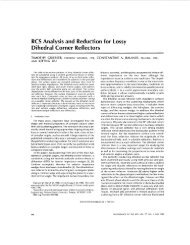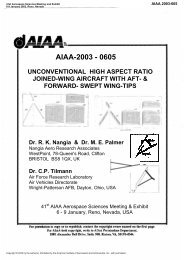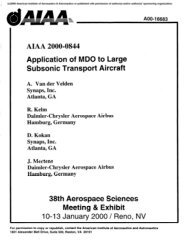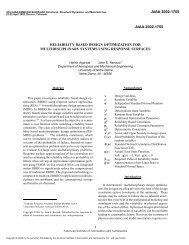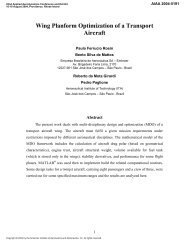The design report
The design report
The design report
You also want an ePaper? Increase the reach of your titles
YUMPU automatically turns print PDFs into web optimized ePapers that Google loves.
Flight Test 6.2<br />
<strong>The</strong> flight test aimed to examine the ability of the EPUAV to perform maneuvers such as<br />
takeoff and landing, as well as its ability to undertake certain mid air operations. For a<br />
successful flight test, all control surfaces must be in excellent working form, as they are<br />
all necessary to maintain control of the vehicle during the mission. <strong>The</strong> mission profile<br />
in this case was of relative simplicity, the aircraft needed to be able to take off, fly for at<br />
least 11 minutes, while performing some basic flight maneuvers and then safely land.<br />
<strong>The</strong> flight tests were conducted on Wednesday the sixth of January, 2009, at a site<br />
approximately 30 minutes from NUAA which had an adequate runway for the task. On<br />
this day, three flights were undertaken by the EPUAV iSpy.<br />
Flight test 1 6.2.1<br />
<strong>The</strong> first flight test was performed with the plane carrying no payload, although the<br />
small spy camera was taped to the underside of the wing to document the crafts<br />
performance. <strong>The</strong> Centre of gravity for the aircraft with no payload had been calculated<br />
to be at 32% of the chord, this position was marked on the wing to in order for the pilot<br />
to have a choice of CG position.<br />
<strong>The</strong> first flight test began on a worrying note. As the plane built up speed down the<br />
runway, it appeared that the landing gear issues had resurfaced. As the plane reached<br />
high speeds on the rough surface, it was obvious that the wheels were shaking and<br />
moving around a lot, indicating that the large forces exerted on them from the<br />
roughness of the ground were having a highly negative impact on the landing gear. <strong>The</strong><br />
aircraft resumed its previous inclination to veer to the right. At higher speeds, the<br />
veering was even more severe, and the pilot was forced to steer the plane left in order<br />
for it to remain on the runway. Thus, the aircraft had to be corrected on takeoff by<br />
ailerons being deflected at takeoff<br />
However, once the plane was airborne, the problems with the landing gear became<br />
obsolete. iSpy performed marvelously in flight, proving that it was able to successfully<br />
turn, climb and dive. In fact, the pilot commented that the in-flight controls were<br />
excellent, and that the aircraft could easily dive and regain height, although he too<br />
acknowledged that the landing gear was problematic.<br />
<strong>The</strong> landing was excellent and problem free. <strong>The</strong> aircraft descended gracefully to touch<br />
down gently without an issue, and was quick to stop once hitting the tarmac, meaning<br />
that the faulty landing gear had little effect.<br />
Once upon the ground, the team examined the landing gear and found that the previous<br />
problems had indeed resurfaced, and were again causing the aircraft to veer right. It<br />
was agreed that this problem could not be solved on site; however the team concluded<br />
that the pilot was clearly incredibly skilled, and able to successfully take off even with<br />
problematic landing gear, and therefore the landing gear would not impinge upon the<br />
actual flight to a great extent.








![Introduction to RF Stealth [Book Review] - Antennas and ...](https://img.yumpu.com/16857890/1/190x245/introduction-to-rf-stealth-book-review-antennas-and-.jpg?quality=85)

